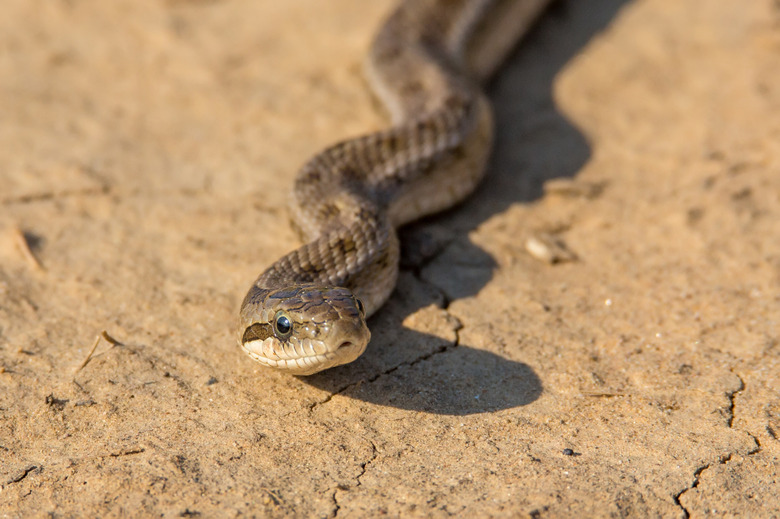Egg-Eating Snakes In Texas
Texas is home to several Colubrid snake species that include reptile and bird eggs in their diet. These snakes are non-venomous and some of Texas' egg-eating snakes are also egglayers. When eating eggs, snakes swallow the eggs whole, as they do with other prey. While eggs enter their mouths, snakes slip their trachea tub underneath the eggs in order to keep breathing.
Rat Snakes
Rat Snakes
Rat snakes receive their name from their usual diet, which includes rats and other small rodents. These snakes also eat bird eggs and young hatchlings. In Texas, native elaphe snake species are the black, Slowinski's, Great Plains, corn, Baird's and Texas rat snakes. Texas' rat snakes live in a variety of natural habitats, including grasslands, forests and mountainous regions. These snakes also dwell near human households and farmhouses. The largest Texas rat snake, the corn snake, grows up to 5 feet when it matures. Other rat snakes range from 3 to 4 feet in length.
Hognose Snakes
Hognose Snakes
Hognose snakes are noted for their snouts, which resemble the noses of pigs. When hunting for prey, hognose snakes look for small rodents, amphibians and small birds. Hognose snakes also eat small reptile eggs. In Texas, the four hognose snake species are the eastern, western, Mexican and dusty hognose snakes. Hognose snakes prefer dry climates and topography with sandy soil; these snakes also live in grasslands. The primary region of the state to find hognose snakes is South Texas. Most hognose snakes are less than 2 feet in length.
Kingsnakes
Kingsnakes
Kingsnakes are called "kingsnakes" since they are known for eating other species of snakes. These snakes are also immune to the venom of venomous snakes, making venomous snakes also a part of their diet. Kingsnakes also eat reptile and bird eggs, small birds, invertebrates, fish and amphibians. Texas' kingsnake species are the gray-banded, prairie and speckled kingsnakes. The primary habitats for kingsnakes are grasslands, forests and semi-aquatic areas, including swamps, marshes and bogs. A kingsnake's average growth is 3 to 4 feet.
Gopher Snakes
Gopher Snakes
Gopher snakes in Texas include the Sonoran gopher snake, bull snake and Louisiana pine snake. These snakes are among the longest snake species in Texas with lengths of up to 9 feet at maturity. Gopher snakes are often mistaken for rattlesnakes due to the coloration of their skin. When agitated, these snakes will shake their tail, similarly to rattlesnake behavior. A gopher snake's diet includes bird and reptile eggs, mammals and birds. This snake species is also an egg-laying reptile species, but does not eat its own eggs.
Cite This Article
MLA
Davis, Skip. "Egg-Eating Snakes In Texas" sciencing.com, https://www.sciencing.com/eggeating-snakes-texas-8482659/. 22 November 2019.
APA
Davis, Skip. (2019, November 22). Egg-Eating Snakes In Texas. sciencing.com. Retrieved from https://www.sciencing.com/eggeating-snakes-texas-8482659/
Chicago
Davis, Skip. Egg-Eating Snakes In Texas last modified March 24, 2022. https://www.sciencing.com/eggeating-snakes-texas-8482659/
